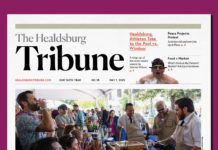Oct. 2-8 is being celebrated as National Newspaper Week. This is the 76th annual observance dating to 1940, covering a span of time that has included great changes to the business of newspapers, as well as throughout our society.
The theme for this year’s celebration is “Way To Know.” It couldn’t be more timely as America gets ready to vote in the Nov. 8 election when a new president, members of U.S. Congress, state, county and local candidates will be chosen to lead our democracy and free country.
We’ve all endured many technological advances, the advent of the internet, social media, smart phones and the unending 24/7 cable TV bloviating. But newspapers — both printed and digital versions — remain just about the only tried and true sources of “way to know.”
Voters and news consumers can be very confused about the real sources of their news. In the days when information had to be transmitted by telegraph, radio wire or the limited capacity of the big three broadcast TV networks, there was no extra room for non-essential info, gossip or narrow-focused bias. Now, most newspapers and news organizations must operate full-time fact-checking desks just to filter out all the false, fake and fluffy “news.”
Relying on just Facebook friends, Google alerts or Twitter tweets is not the best “way to know.” When getting ready to vote in one of our country’s most important elections ever, voters need the reliable, tested and ethical journalism coverage that newspapers provide.
Many people, mostly of an older age, consider their local newspaper a friend or familiar voice. Younger people have less patience or loyalty and get their news from a mobile device in their hand or on their computer screen. What the two generations might not realize is no matter how or where their news is delivered, it all comes from the same original source — a group of journalists working at a newspaper or news organization.
The first National Newspaper Weeks were primarily focused on newspaper carriers and delivery people. Local communities would honor a carrier of the year, usually a young boy who rode a bicycle and tossed papers on neighborhood porches.
What are your oldest memories of your newspaper reading habits? Someone in the household was always earliest to rise and retrieve the paper from the porch. Sections of the paper were shared around the breakfast table and the first conversations of the day were based on the big front page news, or the local sports score.
Life for almost all of us is much busier now and our breakfast conversations might stray from the news of the day, to the latest cat video or political attack. But for most households, the newspaper is still part of the family and a primary source of information.
Each week’s edition of the newspaper offers new connections, introductions to future friends and neighbors and timely reminders about upcoming events.
Newspapers are good for everyone’s health. Blood pressure and heart rates get impacted by what gets printed on the page. Readers get lots of exercise when they are invited to broaden their minds and stretch their beliefs about the current events of the day. Some readers are known to test their vocal chords by talking back or yelling at their copy of the newspaper.
Although every square inch of the newspaper is filled with printed words and local advertising, readers still fill the margins with their personal to do lists while turning pages. A few partake in a timeless game of “Find the Typos.”
It’s not just an old fable; copies of newspapers still make it to an afterlife as birdcage or cat litter liners and the occasional fish wrap. More nobly, some scissor-clipped pages of the newspaper get taped to refrigerator doors or pinned to an office bulletin board.
Now try that with Facebook or Google.
— Rollie Atkinson
63.1
F
Healdsburg
May 15, 2025








